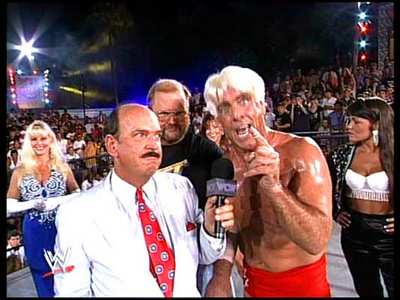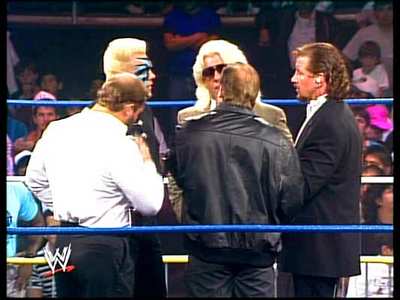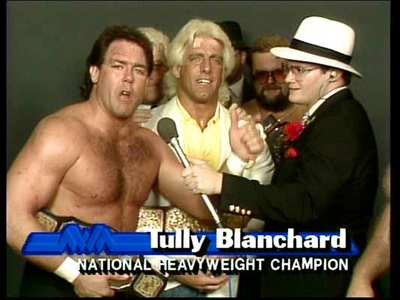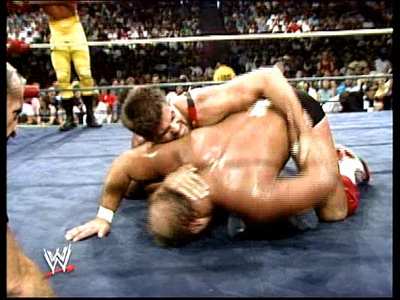Review of WWE: Ric Flair and the Four Horsemen (2 Discs)
Introduction
In January 1986, at a television taping for Jim Crockett Promotions (later to be known as WCW), time had over-run, and the respective bad-guys of Ric Flair, Arn Anderson, Ole Anderson, and Tully Blanchard (the latter along with manager James J Dillon) all had to share the same interview slot, to build up their next matches. Some will say it was fate, because when Arn Anderson instinctively compared the men to the Four Horsemen of the Apocalypse, something clicked. By the following week, the name "Four Horsemen" had stuck.
The group trail-blazed their way through the company, and were constantly the feature attraction. Flair was the perennial world champion, the self-styled "limousine-riding, jet-flying, kiss-stealin`, wheelin`-dealin` son of a gun", Blanchard was the arrogant entrepreneur of "Blanchard Enterprises", and The Andersons were the tough guys that provided the backup. All four were excellent wrestlers, some of the elite of the time.
For the 1980s, the group were also believable. Much of that was down to the fact that, away from the ring, Arn Anderson, Flair, and Blanchard were best friends, and lived up to their arrogant musings. The Horsemen wrestled and partied on a constant cycle, travelling via lear jet and limousine to each next city. Flair would later note that at the time, if he made $1000, he was spending $3000.
Sadly, the original line-up of the Horsemen did not reign as long as their legacy suggests. By 1987, Ole Anderson had been replaced by Lex Luger, though Ole would return to the fold in 1990. From there, many other wrestlers were involved with group, including at various times Barry Windham, Sting, Sid Vicious, Paul Roma, Brian Pillman, Chris Benoit, Dean Malenko, Steve McMichael, and Curt Hennig. Not all had the ability, nor the believability of a Horseman.
"Ric Flair and the Four Horsemen" is a look back at the most famous group of wrestlers ever known, and one which is spoken about almost mythically by long-time wrestling fans. Spread over two discs, it features many matches and interview segments as extras, along with a documentary on the history of the group.

Video
Video is presented in 4:3 fullscreen PAL, and is typically very good for a DVD of this genre. The new interview footage with the likes of Flair, Arn Anderson, Blanchard, and Michael Hayes, looks very good indeed, and the archive footage is just beautiful considering its age, and the limited production values of the time. There are no discernable digital artefacts in the transfer to DVD.

Audio
Audio is presented in Dolby Digital 2.0, and is also very good for a DVD of this genre. The sound is mixed very well indeed, enabling background music to play at quite a level, whilst allowing every word of an interview to be heard clearly. Much like the video, even the archive footage shows no sign of having aged.
There is also a 2.0 French track, as well as subtitles in French and German.

Features
Extras are plentiful over the course of this two-disc set. They begin on Disc One, with ten out-takes from the documentary interviews. These encompass such things as Flair talking about the wildest party in the history of the Horsemen, JJ Dillon talking about his on-camera preparation for the 1988 War Games match, and Barry Windham telling a gruesome story about having a match with Lex Luger. There is a lot of humour in many of these tales, and a real look inside the business as well.
Also on Disc One is the angle in which the Horsemen broke Dusty Rhodes` arm (in storyline). This was one of the most famous angles of its time, and is something that has been copied many times since.
Disc Two features another ten interview segments, this time taken from the television shows of the time. These are a mixed bag from the 80s and 90s, but each shows the incredible interview skills that each Horseman had, Arn Anderson and Ric Flair in particular. Indeed, one of the very best storyline interviews ever is available here, as Arn Anderson reunites the Four Horsemen, along with JJ Dillon, Chris Benoit, Dean Malenko, Steve McMichael, and Ric Flair in 1998. Dillon, Anderson, and Flair all put on exceptional performances here. It is one of the few segments of its type that is required repeat viewing.
But of course, the main thing about wrestling is the matches, and they are plenty of these available too. And in true Horsemen style, they are quite the selection. Things begin with a match from June 1985 - before the formation of the Horsemen - as Flair and the Anderson "brothers" face Pez Whatley, The Italian Stallion, and Rocky King in a six-man tag match. This is an excellent match considering that, to the fans, the team of Flair and the Andersons was leagues superior to their opponents.
We then get a gem from the 1986 Great American Bash tour as Flair defended his NWA Title against Ricky Morton. The work from both men here was stellar, with Flair the consummate heel, and Morton the object of everyone`s sympathy. This was certainly one of the best cage matches that I have ever seen,
The next bout sees Dusty Rhodes defend his TV title against Tully Blanchard, in a First Blood match (first man to bleed loses) at Starrcade 1986. This is a good match, made much more entertaining by the ringside shenanigans of JJ Dillon. We then have the Rhodes-inspired War Games cage match from the 1988 Great American Bash, as Dusty Rhodes, "Dr Death" Steve Williams, Nikita Koloff, Lex Luger, and Paul Ellering face Flair, Barry Windham, Arn Anderson, Blanchard, and Dillon. This is an excellent match, and a bloody one at that.
Continuing the trend of excellent matches, we then get a chance to see Arn Anderson and Blanchard team, firstly against Sting and Nikita Koloff, from the Great American Bash 1988. This is an excellent contest, which features a lot of good wrestling, and some even better story-telling. Anderson & Blanchard - who went to the WWF in 1989 to become "The Brain Busters" - then faced Lex Luger & Barry Windham at the first Clash of the Champions event in 1988. This bout was a step down from the Sting/Koloff affair, but had incredible crowd heat, and was also a good match.
The final match available here is an odd one from 1995, as Flair faced Arn Anderson. Flair plays the subtle heel role here, and Anderson is equally so in the babyface position. The two play out an interesting, almost 1970s style match, which has a slow build to a somewhat surprising end.

Conclusion
The main feature documentary of "Ric Flair and the Four Horseman" looks just like all the recent WWE productions of that type. Thankfully, it also retains their excellent quality. The documentary begins with a look at each of the men involved, before showing how the group came together. Their years-long feud with Dusty Rhodes is detailed, as are several member changes. There is also much talk about how the Horsemen lived their lives together outside of the ring, on the road. The latter chapter in particular brings up some moments of humour, though the documentary as a whole is a real joy.
The feature benefits greatly from the excellent new interview footage, and the incredible archive video. The new interview footage moves the documentary along without the need for narration, and it is a treat to see and hear Arn Anderson, Tully Blanchard, and JJ Dillon in longer speaking roles (Flair is still a regular on WWE TV). The archive footage is nothing short of incredible, and clearly there was a lot of research undertaken to find clips to suit every chapter. Very little of the footage, if any, has been available commercially in the past, and it is a particular treat for UK viewers to see the footage from Jim Crocklett Promotions, as television from that company never aired here.
If there are any minus points regarding the documentary, perhaps one is the fact that Arn Anderson often speaks in keeping with the script. In other words, he talks about breaking Dusty Rhodes` arm as if it were more real than it actually was. It wouldn`t necessarily be a bad thing, but he sticks out like a sore thumb when everyone else is happy to discuss behind the scenes matters.
Another issue is that some well-remembered members of the Horsemen do not appear in the new interview footage. Ole Anderson - who has a long-standing grudge against Vince McMahon - is one, as is Sid Vicious. It is understandable that Sting was unable to comment due to being under contract with another wrestling company, but what about the likes of Lex Luger or even Chris Benoit?
None of the above, however, manage to in any way spoil what is an excellent insight into a fascinating group of people, from a time when wrestling was tremendously popular. With superb extras also available, this two-disc set is a must for any fan of 1980s American wrestling, and for those who wish to know more about it.
Your Opinions and Comments
Be the first to post a comment!